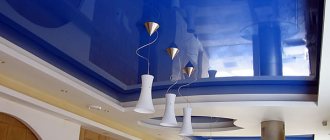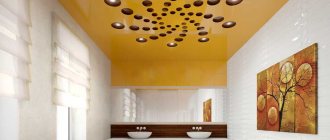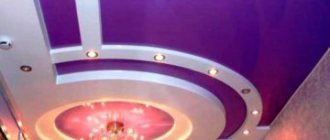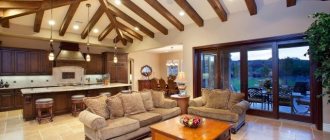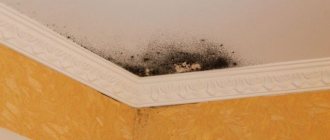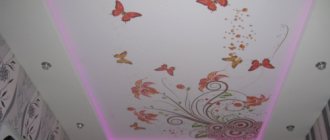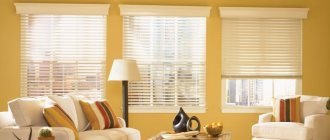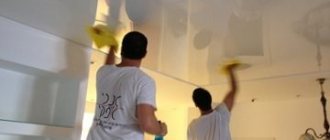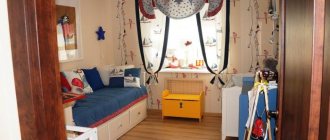In addition to the traditional fastening of curtain rods to a wall or ceiling, another original option is available with a suspended ceiling - a hidden curtain. This arrangement opens up new design possibilities and makes the room appear higher since the bar is not visible. To do this, you will need to make a suspended ceiling with a niche in which the cornice will be hidden. This way, the curtain mount will be invisible, since the crossbar is recessed into the interceiling space. In this article we will look at how to choose the right cornice and calculate the dimensions of the structure. We will also examine in detail five ways to create a hidden niche in a suspended ceiling.
Recommendations for choosing a cornice
Before purchasing, it is advisable to decide on the approximate design of the curtains. For light curtains, a plastic crossbar is sufficient, but for heavy curtains you will need a durable aluminum or metal curtain rod.
Let’s immediately say that both ceiling and wall models can be installed in a niche, but it is better to give preference to the first option. Such cornices are much more compact and easier to hide behind the tension fabric. Otherwise, you will need to lower the ceiling lower, which will reduce the height of the room.
Curtains are hung in several rows: just tulle, with curtains, or additionally decorated with lambrequins. Depending on the number of curtains, you need to purchase one, two, three or four-row curtain rods. It’s also better to think through this point in advance.
Read more: How to choose the right ceiling curtain rod
Advice! If you hang a ceiling rail across the entire width of the room, the curtains can be pulled apart on both sides of the window. This will allow more light to enter the room.
Photo of curtains under a suspended ceiling
Read here Decorating curtains: 108 photos of the finishing touch in arranging a designer room
Did you like the article? Share 
Dimensions and depth of niches for curtains
First of all, the dimensions depend on the chosen cornice and its location in the room. For a lightweight design designed for tulle and thin curtains, a width of a few centimeters is sufficient. For a wider one, on which two or three types of fabric of different weights are hung, you will need at least 10 cm.
Other factors also influence the parameters of a niche for a curtain in a suspended ceiling:
- When determining the width, take into account the dimensions of the window sill and the position of the battery. In order for the curtains to hang evenly, they should not touch the radiator. But too much indentation reduces the usable area of the room. As a rule, the optimal width is 20-25 cm.
- The length most often coincides with the length of the wall. But it may decrease depending on the layout of the room, for example, when the window is located in the corner of the room. The minimum size is slightly wider than the window, at least 10-15 cm on each side, while the curtains should cover the edges of the window sill.
- The depth of the eaves niche depends on the installation method and frame parameters. The minimum distance from the rough ceiling to the suspended ceiling is 5-7 cm. Additionally, it is necessary to take into account the dimensions of the cornice, hooks and curtain tape; they must be completely hidden behind the canvas. In addition, about 8 cm should be added to compensate for the viewing angle, since we are looking at the niche from bottom to top. Thus, the optimal depth is 15-20 cm. It is also important to provide additional space if you plan to install a hidden lighting system.
Note! In a niche that is too deep (for example, in two-level structures, the indentation can reach 40-50 cm) it is inconvenient to attach the crossbar and hang curtains.
Cornices for suspended ceilings - invisible fastening of cornices to suspended ceilings
In this case, the baguettes are attached directly to the main ceiling, and the decorative PVC sheets are mounted on a special stand, which is fixed in front of the cornice. Thus, the slats remain invisible, and the curtains hang from under the canvas in a cascading flow. This method is more difficult to implement, but the effect is impressive.
You need to start working on installing the curtains in a hidden niche before measuring the decorative fabric. This is due to the fact that the size of the niche will depend on the dimensions of the baguette. If you ignore the installation technology, then after installing the canvases, material residues may form. Usually the niche is made 10 cm wide.
The algorithm of actions is as follows:
- first you need to secure the cornice to the base ceiling with dowels;
- a wooden beam is fixed at a short distance from the baguette (3-5 mm). Next, profiles for the tension fabric will be attached to it. The wood is pre-coated with a layer of antiseptic or primer;
- the profiles are mounted on the side of the baguette in such a way that, after tension, the canvas completely covers the beam.
How to attach a ceiling cornice to the ceiling in more detail for each type.
Preparing the ceiling for a hidden cornice
The surface must be cleaned of any remaining paint or plaster. To do this, take a spatula. You can lightly moisten the ceiling, so the whitewash will come off faster. If cracks are found, they are sealed.
Advice! In cases where it is not planned to stretch the canvas in a niche, it is better to putty the concrete and cover it with white paint. The pocket will look more aesthetically pleasing.
Features of suspended ceilings with a hidden niche under the cornice
A niche for curtains on suspended ceilings has distinctive features in terms of the method of location, type of installation (structure, material), length, height (depth) and level of design complexity. This type of hanging is suitable for vertical curtains (roller, Roman), Japanese panels, as well as for ceiling or wall mounting.
Main features of installing a ceiling recess for curtains:
- The entire wall. The niche can match the length of the wall. In this case, the window visually looks wider and higher. In addition, such a structure is much easier to install.
- For a niche along the length of the window opening, indentations are made on each side (minimum 500 mm) so that there is additional space for the curtains to be pulled back, and when closed, the sun's rays do not enter the room.
- The height of the recess under the cornice. For an aesthetically pleasing window, the hooks of the ceiling cornice rail must be completely hidden from view. For this purpose, the height (depth) of the niche is made no less than the length of the cornice hangers and the width of the curtain drapery tape. The depth of the niche should be no more than 35-40 cm, otherwise it complicates the task.
Important! When calculating the width of the recess under the cornice, the removal of the window sill and the heating radiator must be taken into account - for the correct vertical position of the falling curtain.
Methods for creating a niche in a suspended ceiling
The shape of the structure can be the entire length of the wall or the size of a window with straight or rounded corners. There are several ways to make a niche for curtains in a suspended ceiling. They differ in design, manufacturing complexity, appearance and installation technology. To install a hidden cornice, use a plasterboard box, a timber frame or a special profile for suspended ceilings. Let's consider each method in detail.
Plasterboard box
A box is erected along the wall made of gypsum plasterboard and a metal profile, which separates the place where the cornice is attached from the rest of the room. A suspended ceiling is subsequently attached to it. This design allows you to install spotlights and decorate the ledge with a decorative baguette.
Box dimensions:
- length corresponds to the dimensions of the room;
- width - 5-10 cm; to install spotlights, you will need at least 30 cm;
- depth - slightly below the level at which the canvas will be stretched.
Installation is carried out as follows:
- Mark where the box should be located.
- At this point, a guide profile for plasterboard is screwed to the ceiling.
- Bends are made to the walls along the depth of the structure.
- A horizontal jumper with attachment points in the partitions is mounted to them.
- The guides are fixed together with vertical sections of the ceiling profile in increments of about 60 cm.
- At the level of the future stretch ceiling, the box is reinforced. To do this, an additional guide profile is mounted between the vertical jumpers. A baguette for the stretch ceiling will be attached to it in the future.
- Sew up the frame with plasterboard, starting from the vertical sides.
- Seal the seams with putty, then paint. After this, they begin to stretch the fabric.
If spotlights need to be built into the box, a wider structure will be required (approximately 30-50 cm). In this case, the assembly of the frame becomes more complicated. To increase the strength of the structure, additional horizontal jumpers are installed from the ceiling profile, which connect the lower guides. The fastening step is approximately 60 cm. The lintels are additionally fixed to the floor slab using direct hangers or sections of the ceiling profile. There is still room inside to place lights and wires.
Features: if the niche is narrow (20-30 cm), installing drywall in it will be inconvenient. Then the order of work changes. First, they assemble the wall on the floor from the window side, then attach it to the ceiling. The remaining part of the frame is attached to it and sheathed.
The advantage of a plasterboard box is that when hanging curtains there is no contact with the suspended ceiling. That is, the possibility of accidentally damaging the canvas is eliminated. But there are also disadvantages. The big disadvantage of a plasterboard box is that its assembly takes a lot of time, after which it still requires finishing in the form of putty and painting. In addition, you have to wait for the paint to dry before you start stretching the canvas.
Timber mortgage
This method of installing a hidden niche has two options. Let's look at a simpler one first.
The first step is to install the embedded beam. To do this, take a wooden beam that is the same length as the wall or slightly shorter. Usually a section of 30x30, 40x40 or 50x50 cm is suitable. The timber is attached to the rough floor strictly horizontally. A level or a thread stretched from one wall to another will help with this. A ceiling or wall molding is screwed to the bottom edge, into which PVC film is subsequently tucked. The beam itself should be located 5-10 mm above the level of the stretch ceiling. The gap is closed with an F-shaped decorative insert.
To install the mortgage, it is convenient to use reinforced metal corners. Then the tree can be located either close to the ceiling or at some distance. The mortgage will be on the same level, even if the floors are uneven. In addition, the resulting gap will serve to ventilate the space under the ceiling. Mold will not appear there, and the film will not be retracted when opening and closing the doors. But if the surface of the ceiling is flat, you can fasten it with long self-tapping screws through the mortgage directly to the floor slab.
Attention! It is better to use laminated veneer lumber; it practically does not deform from moisture, and over time the structure will not “lead.”
This method of installing a hidden cornice in a suspended ceiling is easy to implement. From the side of the room, the structure looks flawless. But it is not without its drawbacks. The fact is that on the reverse side there is a visible gap, mortgage and fastenings. They rarely look at them on purpose, raising their heads up near the window. But if the apartment has a balcony or loggia, then this drawback will be visible.
To hide the “wrong side”, choose a more complex option with a bend in the fabric. To do this, a fender profile is attached to the bottom of the beam, and a ceiling molding is attached to the vertical plane on the side of the window. The gap for mounting the canvas should be located flat against the ceiling. Then, when stretching, the PVC film is bent over the bumper and tucked into the baguette.
Thus, the canvas hides all structural elements and the niche looks aesthetically pleasing from any angle. In fact, it turns out to be a two-level ceiling, in which the lower tier occupies almost the entire room. But making such a design is more difficult and longer than the previous version.
If a hidden pocket is required not for the entire wall, but only for the size of the window, a U-shaped embed is assembled from timber.
Note! It is important that there are no burrs, damage or noticeable joints at the bend. When stretching the fabric, it is necessary to avoid wrinkles or folds. It is recommended to start installation from this area.
Special profile for cornices
In the finished version, the curtain pocket looks the same as with a fold and fold of the fabric; the structural elements are not visible and are completely covered by the stretch ceiling. But instead of timber, a special metal profile BP-40 is used.
It is a square aluminum pipe with a gap for inserting the blade. Available in a length of 2.5 m and a size of 40x40 mm, the bend height is 3 cm. Unlike timber, an aluminum profile makes it easy to create a niche with rounded corners. To do this, cuts are made in the bending areas every 5-10 mm.
Installation is similar to the method with timber, but takes less time, since there is no need to screw on additional baguettes. This option of creating a niche for a cornice in a suspended ceiling is somewhat more expensive. But many choose it because of the simplicity and greater reliability of metal compared to wood.
Niche profile
The previous methods are not designed to cover a hidden pocket with a suspended ceiling; the surface of the recess will have to be painted. A special baguette, “Nisha Plus,” will help you avoid this. The profile has a width sufficient to install a cornice on it. There are gaps on both sides for fixing the canvas, one of which is lowered below to hide the structure.
Profile length - 2.5 meters. This is enough for small rooms; in wider rooms the baguettes will have to be joined. It is important to ensure that there are no gaps or differences in level at the joints.
Installation is quite simple: metal corners are screwed to the ceiling, then a profile is mounted to them (with the low part towards the room). Subsequently, a ceiling cornice is attached to this structure, and the niche is covered with a piece of tension fabric. The material can be the same as in the rest of the room or simpler and cheaper.
Curtain profile
This is another way to cover the top of a curtain niche with a stretch fabric. The method is even simpler, since a baguette with built-in fastenings for curtains is used - curtain profile PK-5.
The product is a white-painted aluminum tire with three rows of roller hooks. There is no need to additionally attach the cornice. On both sides of the profile there are grooves for fixing the tension fabric and one elongated edge to hide the niche. The standard size is 3.2 m, the height of the bumper is 5.5 cm. Installation is similar to the previous option.
Cornices for suspended ceilings - technology for fastening ceiling cornices
To decorate rooms with tension structures, wall or ceiling types of curtains are used. Before installation, it is necessary to prepare the surface so as not to harm the suspension system, and securely fasten the product.
Visible method of fastening cornices for suspended ceilings
This method involves installing a baguette on a pre-mounted wooden beam, disguised with a decorative cloth. This option is very popular. It is widespread not only among masters, but also among clients. It assumes the following procedure:
- before installing the canvas, points are marked on the base surface indicating the places where the cornice is attached;
- a line is drawn where marks are placed in an amount corresponding to the number of dowels;
- Markings are applied to the walls, outlining the perimeter of the room. It will become the basis for attaching the profile into which the canvas will be tucked;
- then, using a puncher, make holes according to the marks and insert dowels;
- The wooden beam is fastened in such a way that after tensioning the canvas, it adheres to the coating, but does not damage it. Before screwing a wooden plank, it is coated with special protective impregnations or a hydrophobic primer, which will extend the life of the wood.
Adjust the height of the mortgage using mounting wedges. They are hammered between the base base of the ceiling and the timber;
- stretch the fabric;
- Screw the curtain onto self-tapping screws through PVC film or fabric. The holes in the coating are first burned, not rolled. This reduces the likelihood of causing damage to the canvas. Special polymer rings are placed where the self-tapping screws pass through the vinyl.
If the technology for installing cornices was followed at all stages of the work, then the mortgage will remain invisible.
How to make lighting in a niche with the effect of floating curtains
To illuminate the curtains, an LED strip is glued into the niche on the side of the room. If you choose the option with a profile for two-level ceilings, purchase a baguette with special recesses.
This creates the impression of a higher room. The LED strip can be mounted independently or combined with hidden lighting around the perimeter of the entire ceiling.
Some tips:
- Tapes are available in different colors and even with the ability to change lighting, the latter option allows you to give the interior of your home a different mood;
- for curtain lighting, it is better to mount a separate switch;
- Tapes with a remote control are available for sale, which allows you not only to conveniently turn the light on and off, but also to change the color of the lighting.
Choosing curtains for suspended ceilings
A suspended ceiling does not require the use of cornices. If you have low ceilings, it is better to use a hidden curtain on a suspended ceiling and the most convenient curtain rods. Many people wonder which curtains are better for a suspended ceiling. This directly depends on the design of the cornice.
Features and advantages of hidden curtain rods
Hidden cornices with suspended ceilings have a number of advantages:
- they are easy to install;
- their appearance does not matter;
- the ceiling under the cornice does not need to be finished if the plaster does not fall off (otherwise, plasterboard finishing can be used);
- a hidden curtain allows you to hang the curtain so that it falls from the ceiling, this visually increases the height of the room;
- a hidden niche in the ceiling makes it possible to position the cornice so that the tension curtains do not touch the window sill (regardless of its width);
- hidden installation allows you to place lighting (there are certain types of cornices that provide space for an LED strip).
If the decision has been made to make a suspended ceiling and the curtain has already been selected, then it is necessary to prepare in advance a place for the niche in which the cornice will be mounted.
Open ceiling curtain for suspended ceiling
An open cornice makes it possible to highlight its design. The most popular options are carved wood models or imitation stucco molding made of polyurethane.
Built-in ceiling cornices are suitable for any room, regardless of its size and design. They are suitable for both office space and apartments. Installation of the structure can be either hidden or open. The main task is to create a harmonious combination of the cornice with the ceiling and walls. You can hang the ceiling curtain without much effort.
It is recommended to install a wide frieze in an open space to highlight its appearance. Another popular technique is to design polyurethane baguettes in the same style as the cornice.
Photos of curtains in the ceiling niche
The stretched fabric opens up wide design possibilities. And this applies not only to the surface of the ceiling itself. A new way of designing a window opening is emerging. The curtain rod can not only be screwed to the wall or ceiling, but also hidden in a special niche. Then only the curtains will be open to view. The implementation is simple. You can mount the structure yourself using various materials. An easier way is to install special profiles: a niche or curtain.
How to attach a cornice to illuminate a stretch ceiling
The method of installing cornices designed to mask decorative lighting requires knowledge of some nuances and subtleties. Installation is carried out in the following order:
- The attachment points are primed using a primer;
- Using a building level, apply markings along the curtain installation line;
- a wooden beam is screwed to the line;
- Using liquid nails, the curtain fastener is attached to the strip and wall. An alternative to liquid nails is acrylic putty;
- to make the corners neat, they are cut out with a miter box;
- install baguettes under the tension fabric. The distance from the profile to the cornice should be at least 7-10 cm;
- LEDs are prepared. The protective film is removed from the tape and the individual elements are soldered;
- contacts are protected with adhesive patches;
- after the glue has dried, remove the protective paper from the tape and attach the light source to the cornice in such a way as to ensure the shortest possible distance at the joints;
- At the final stage, the power wires are connected, LED amplifiers, power supplies, controllers are mounted, and the lighting functionality is checked.
If you wish, you can choose a tape with single-color or multi-colored backlight. Experts advise purchasing smooth switching mechanisms along with LEDs, which will provide an interesting lighting effect and extend the life of the devices.
It is not difficult to understand how to attach a cornice for suspended ceilings. The main difficulty is choosing an installation technique that is suitable for a specific type of cornice without damaging the tension fabric. Therefore, at all stages of installation work you need to act with maximum precision and accuracy. If you follow the above recommendations, you will be able to securely secure the cornice under the suspended ceiling.
Useful materials about ceiling curtains - choosing a product and installing it yourself.
Method of installation of ceiling models
There are two ways to attach the cornice to the ceiling. Which one to choose depends on the design project, the qualifications of the installers and the client’s wallet.
Outdoor installation
With the open fastening method, the cornice is in plain sight. It is attached directly to the ceiling film. However, the thin fabric is not able to hold a cornice with heavy curtains. The ceiling will simply deteriorate. What should I do?
- Before calling the craftsmen to install the ceiling structure, you need to decide on a specific model of cornice and purchase it.
- This will allow the workers to make the correct markings and install the embedded beam, to which the fasteners will be carried out.
- After stretching the film using self-tapping screws, the cornice is attached to the embedded element.
Closed installation
If you want the curtains to flow straight from the ceiling, then you need to make a niche in front of the wall. This will visually raise the ceiling. Here you can use both ceiling and wall models.
- So, the suspended ceiling will end 15-20 cm from the wall. The indentation is needed so that the curtains do not rub against the ledge of the ceiling structure when moving.
- The width of the niche is calculated by the depth of the folds in the fabric that will form when the curtains are opened. If you like models with eyelets, then calculate in advance how much space they will take up when folded.
- Since the profile is not attached to the wall, you need to build a stop to which the harpoon that tensions the film will be attached. To do this, a specialized profile or an ordinary wooden beam is attached to the ceiling.
- After installing the canvas, the cornice is attached. Of course, it is more convenient to install it before the film is stretched. But with hot installation there is a risk of damaging the plastic.
- A cornice of any design can be installed in a niche, from a string to a complex design of Japanese sliding models. The main thing is that you feel comfortable using it.
- Small hooks hold the tulle well and are completely invisible. Rings and clothespins are easier on your hands.
Installation instructions
Traditional way.
- First you need to purchase a cornice and prepare a mortgage.
Having done this in advance, you will not have to disassemble the ceiling structure later. Wooden beams (less commonly, metal profiles) are usually used as a mortgage. It is set according to level. The corners and edges of the timber must be carefully sanded. Scheme for attaching the ceiling cornice directly to the stretch ceiling fabric - Fastening the mortgage.
For fastening, use a hammer drill and dowels. Support block for subsequent installation of the cornice - Marking.
At this stage, you need to try the cornice on the canvas and mark the locations of the fasteners. The places where the curtain will be attached must coincide with the location of the mortgages. Marking the surface for installation - calculating the width of the niche - Installation.
Installation is carried out using self-tapping screws. It is better to additionally protect the attachment points with reinforcing tape. Installation of a mortgage under a ceiling curtain
Note! The traditional method is easier to fasten metal products. Their high rigidity allows you to make fewer mortgages.
A plastic tire is installed on a suspended ceiling using an embed
Attaching a hidden cornice.
- Buying a cornice. In modern kitchens, bedrooms, and living rooms, cornices are increasingly hidden from prying eyes in special niches. In a niche you can install a curtain made of any material you like. You only need to focus on the weight of the curtains.
Three-row plastic cornice is well suited for installation in a nicheThe optimal distance of the inner edge of the niche from the wall with a window is 100-200 mm, depth 100 mm
- Installation of stretch ceiling. At this stage, the niche itself is formed. When installing the ceiling, you need to leave a small rough area near the window. It will be possible to install lighting there in the future. It will make the interior of the room more attractive.
Scheme for attaching a ceiling cornice in a niche under the cornice without bending the canvasLayout of a hidden cornice behind a suspended ceiling in a niche under the cornice with a bend in the canvas
- Installation of cornice.
For this, use ordinary self-tapping screws. By disguising the curtain, you can create an interesting design effect - flowing curtains. Such a hidden curtain looks amazing even in the photo. The niche-cornice for a suspended ceiling looks very impressive
Selection and installation of ceiling cornice
There is an opinion that cornices are installed on the ceiling only to create an appearance. In fact, this product also carries a functional load.
Thus, it is thanks to the correct installation of cornices that it is possible to increase the height of the room, securely fasten curtains or install additional lighting.
If we compare ceiling and conventional cornices (in the classic version), they are almost no different. The device has the form of a flat bus fixed to the ceiling (the latter can be tensioned, concrete, suspended, wooden or any other).
Articles on the topic (click to view)
- Step-by-step instructions for creating Japanese curtains with your own hands
- Photo of the kitchen and bedroom interior with Japanese curtains
- Electric drive for curtains
- Photo of interior design 2020 with curtains
- Photo of a living room with panoramic windows
- Photo of the living room interior with curtains on the bay windows
- Kyarniz for a sloping window
It is thanks to the cornice that the design of the room can be completed and any design ideas can be realized.
If we consider designs for installation under a tension fabric, there are two designs:
- product for hanging curtains. The purpose of the cornice is clear. The only problem is how to install the product to the tension fabric and not damage it. Here it is important to create conditions under which fabric or film (PVC) ceilings remain intact and are not damaged at the time of installation. If the structure is attached to the wall, then there are no requirements for proximity;
- product for organizing hidden lighting. The peculiarity of the cornice is that it is made using polystyrene, and then fixed to the wall with glue. Next, the tape itself is fixed in the inner surface.
If we divide the cornices according to the material used, then it is worth highlighting the following options:
- tree. Such cornices are distinguished by their massiveness, beauty and original design. At the same time, they have a presentable and original appearance;
- aluminum. Pros: Durable, lightweight and affordable. On the other hand, there are not as many options for execution as we would like;
- steel. Curtain rods made of steel are used to hold heavy curtains. Pros: reliability, ability to decorate with various wooden or plastic elements. Disadvantage: high price;
- plastic. Products made using plastic are in greatest demand. They have great strength, lightness and low price. In addition, there are enough design options to choose the right product for a specific interior.
When choosing curtain rods, it is worth considering that they are presented in a wide price range and in different price versions. As a result, there is no doubt about choosing a product that matches the color of the tension fabric being installed.
Installing a ceiling cornice in a suspended ceiling
As for installing the cornice, it is recommended to start this work after stretching the PVC film. But recently, many people prefer installing wall cornices.
There are several reasons:
- Installation of a ceiling cornice is more expensive. On average, additional costs are estimated at 2-2.5 thousand rubles. If we are talking about installing a wall cornice, then you can reduce installation costs;
- many do not want to violate the integrity of the PVC sheet, believing that in this way they will be protected from a flood from above. In addition, when replacing curtains with other products, fewer problems will arise;
- A wide assortment opens up the opportunity to choose a product according to your own preferences. The main thing is to pay attention to the distance between the cornice and the ceiling. It should be such that sharp hooks do not touch the surface and cannot damage it.
An interesting fact is that profile cornices have the same appearance as traditional products. At the same time, the features of the profile design eliminate even the slightest risk of damage to the canvas. The most dangerous installation of a cornice on a film ceiling.
As for fabric made of fabric, it is not at all afraid of such influences.
The installation of a ceiling cornice under LED lighting deserves special attention. Here, to carry out the work, it is worth preparing material for fixing the tape (for example, acrylic putty, liquid nails), a knife, a miter box, matches and other products.
From the start, tape is glued to the inside of the cornice. In this case, pay special attention to the joints and corners. Afterwards, prepare the light source itself (tape), focusing on short circuit protection.
Expert opinion
Mikhailova Maria Vasilievna
Furniture store manager. Knows everything about comfort and interior design
The LED strip is assembled from segments and joined together using a soldering iron. To reduce the risk of short circuits, the protective (foil) paper must be removed.
As for the ceiling cornice, it should be installed even before wallpapering. In this case, the fastening is carried out directly on the plaster. The main thing is to prime the surface before installation.
If there is a need for cutting at an angle, then you should use a miter box for this purpose. As an option, the use of special corners is allowed.
The cornice can be fixed not only to the surface of the wall, but also to the mortgage that was previously fixed. For more reliable fixation, the use of special fasteners is permitted. In this case, the distance to the PVC film should be 8-10 cm.
As for the installation of the LED strip, the sequence is as follows. First, the paper is dismantled, after which the tape is glued to the cornice. Special attention should be paid to the places where the tapes join each other.
This is important to avoid the occurrence of dips. In addition, the joints at the points where the wires are connected should be as short as possible (no more than the distance between two LEDs). Once the LED strip is secured, you can begin applying voltage.
Watch the video: installing a ceiling cornice, curtains on a suspended ceiling
To ensure reliable contact, it is important to use special pliers (“crocodiles”). The main requirement is reliability. At the final stage, you can install the power supply, controllers and LED amplifiers. As for the connection diagram itself, it can be adjusted at any time.
Installation of suspended ceilings - video to help
Practice has shown that for the correct installation of tension fabric, it is important not just to study the theory in books, but also to watch training videos.
Experienced workers share information on how to carry out installation, what secrets must be carried out, what points to pay maximum attention to, and so on.
From the videos you can learn:
- correctly install the cornice in various ways;
- install a suspended ceiling;
- eliminate defects that arose during the installation process;
- attach LED lighting and perform other related work.
The main thing is to watch several videos to find out as many options and recommendations from experts as possible.

